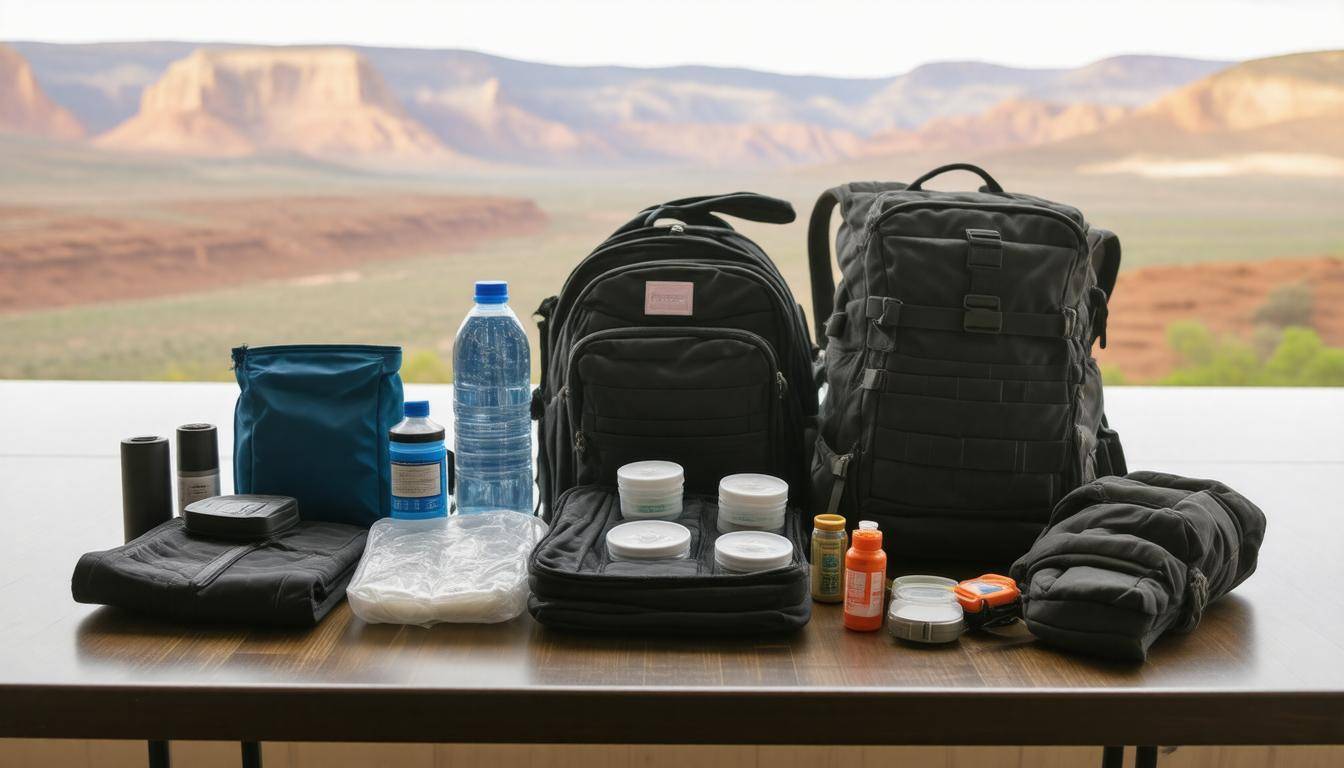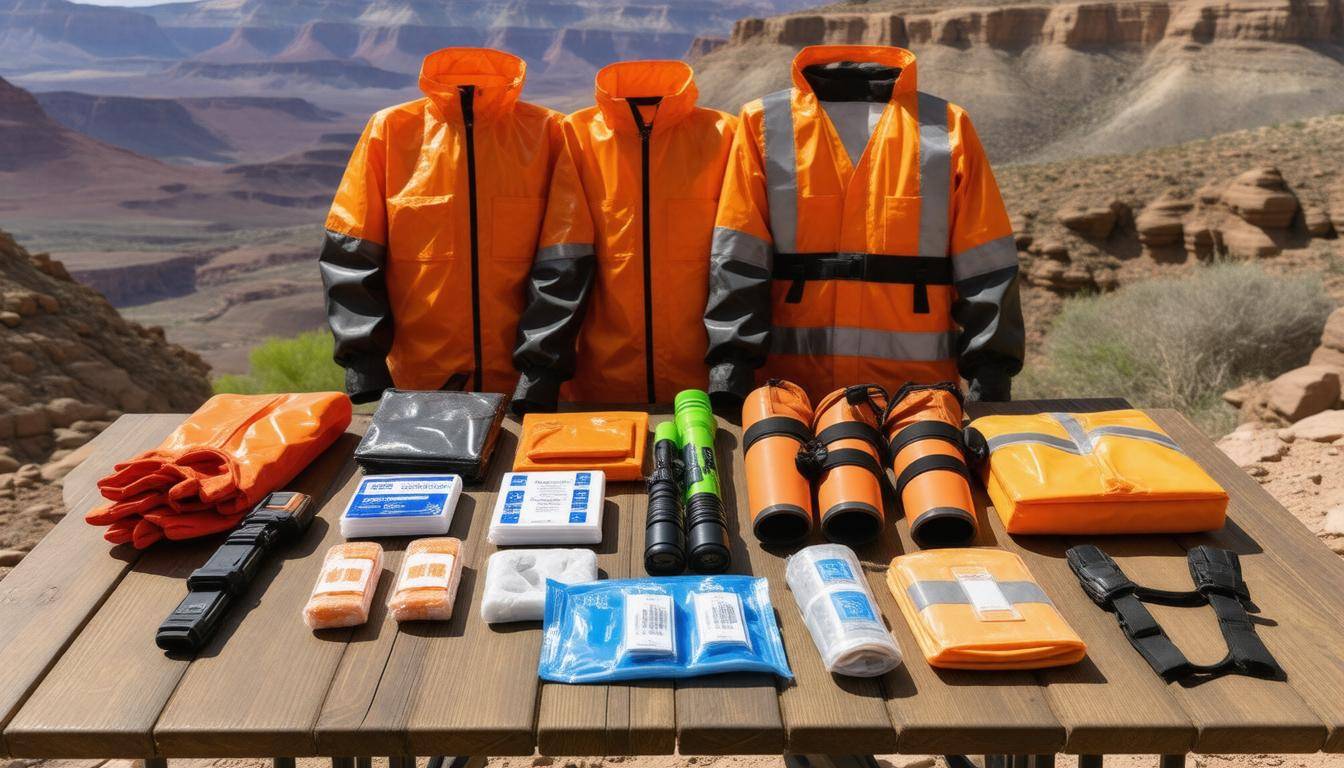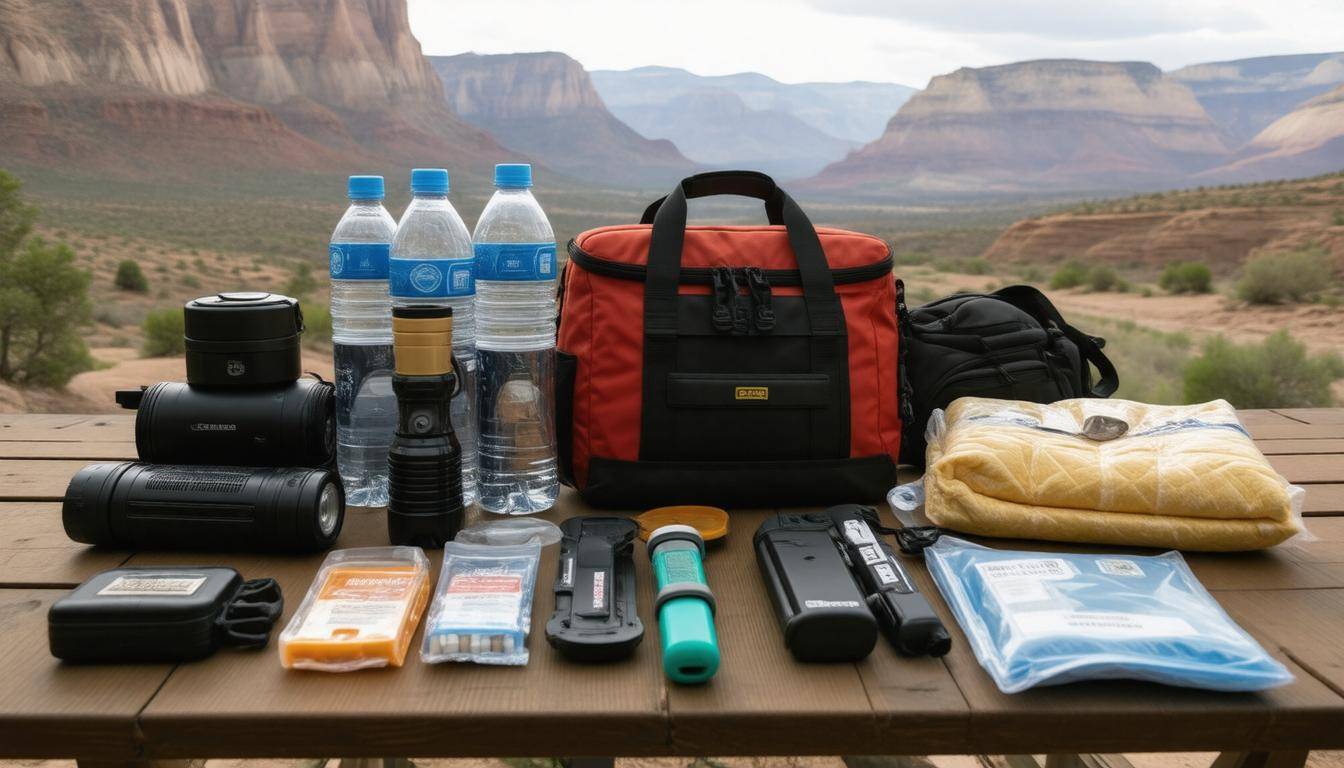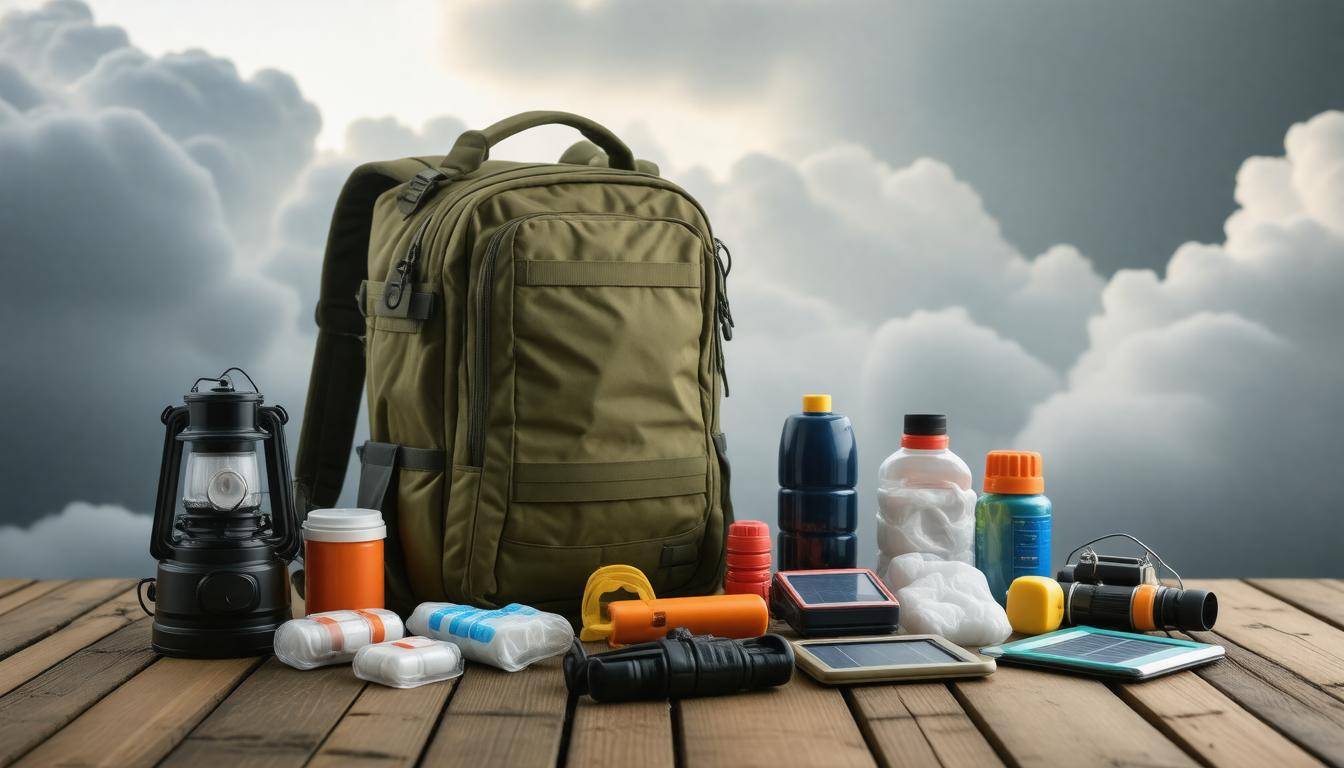When venturing into the stunning yet unpredictable canyons, one thing is clear: being prepared for a flash flood isn’t just smart; it’s essential. As rising waters can come out of nowhere, having the right gear and supplies can mean the difference between staying safe and facing disaster. After all, who wants to be caught off-guard when you’re exploring nature’s beauty? In my time spent outdoors, I’ve learned firsthand that preparation not only empowers adventurous spirits but also nurtures peace of mind. So, let’s guide you through everything you need to build your very own Canyon Flash Flood Kit, ensuring that your next adventure is both thrilling and secure.
A Canyon Flash Flood Kit should include essential items such as non-perishable food, water (at least one gallon per person per day), a battery-powered or hand-crank weather radio, first aid supplies, essential medications, sturdy shoes, and a flashlight with extra batteries. Additionally, it is crucial to have important documents secured in waterproof bags and an emergency plan that includes evacuation routes specific to your canyon location.

Canyon Flash Flood Survival Gear
One of the most essential items in your gear kit is a sturdy, waterproof backpack that will safeguard your equipment from unexpected downpours or splashes. Many canyoners recommend opting for a pack crafted from high-quality materials featuring a roll-top closure—this design not only prevents water from seeping in but also helps secure your belongings during tumultuous conditions. Protecting your gear ensures access to crucial supplies when you need them most.
Moving on from backpacks, let’s discuss another critical item: high-quality climbing rope. It’s not just any rope that you need; look for dynamic ropes specifically designed for climbing. Unlike their static counterparts, dynamic ropes are engineered to absorb the force generated by a fall. This feature becomes paramount in emergencies—if you find yourself needing to navigate through sudden floodwaters or perilous terrain, knowing that you have a dependable lifeline can provide peace of mind. It’s interesting to note that 75% of canyoners carry a multi-tool for emergency repairs, showcasing common issues that can arise during an expedition.
Next on our list are headlamps with extra batteries. As we know, conditions within canyons can change as quickly as the weather if rain rolls in unexpectedly. When visibility plummets, having a reliable light source is vital—not just for navigating tricky paths but also for signaling rescuers should the situation take a turn for the worse. Investing in a headlamp with strong lumens output and changing the batteries regularly enhances your chances significantly during critical moments when time is of the essence.
Furthermore, don’t overlook waterproof first aid kits in your preparation! These kits should contain everything necessary to address injuries sustained during unexpected falls or flooding. Personal anecdotes suggest including items like compression bandages and antiseptic wipes to treat wounds effectively—and let me tell you, you may need them more than you think! For example, Joe Cain’s experience navigating Spry Canyon underscores this urgency; he credited his mini-emergency kit with preventing hypothermia after sustaining injuries during his trek.
With these well-thought-out supplies at hand, you’ll be better prepared for any challenges mother nature throws your way while enjoying the breathtaking beauty of canyon lands.
As we explore further, it’s essential to examine specific types of gear that can significantly enhance your preparedness against water-related emergencies.
Essential Waterproof Items
In the world of outdoor adventures, particularly when canyoneering, having reliable waterproof equipment can be the difference between a fun experience and a nightmare scenario. When floods threaten your safety, protecting your essentials becomes paramount. Dry bags take center stage here. These bags come in various sizes, making them perfect for stowing away food, clothing, and electronics. Choosing dry bags rated for submersion offers an added layer of security; this means you can confidently wade through unexpected waters knowing your gear is sealed safely within.
Imagine you’re navigating a narrow canyon when a sudden downpour turns into a rapid torrent. Your dry bag can be your best friend as it floats atop the rushing water while keeping its contents pristine inside. By selecting bags that are lightweight and durable enough for repeated use—around 60 outings should be expected—you ensure functionality without overburdening yourself during treks.
But it doesn’t stop there. Along with dry bags, waterproof phone cases and GPS devices need to earn their places on your checklist. In today’s tech-savvy world, smartphones serve not only as communication tools but also as navigation aids. With a waterproof case that allows operation even when submerged, you can utilize mapping apps or emergency services without fear of water damage. This becomes crucial when you’re in unfamiliar terrain where direction may become disoriented by nature’s chaos.
Furthermore, consider carrying portable power banks that are also waterproof or stored in dry bags. Emergencies often swell in size when our devices run out of battery during critical moments. Having charged devices ensures access to information and communication lines essential for safety.
It’s fascinating how much modern technology plays a role in survival tactics today; gone are the days of solely relying on compasses and paper maps. The advancements allow for more efficient navigation but require careful protection against the elements.
As important as these waterproof items are, there’s another set of essential tools that will enhance your preparedness for unexpected situations in the wild.
Safety Equipment and First Aid Supplies

In any adventurous pursuit, especially in environments prone to sudden natural disasters such as flash floods, having the right safety gear is not just a question of convenience; it could be a matter of life and death. Tailoring your safety and first aid equipment for quick access ensures that you can rapidly respond to emergencies. Imagine being trapped by rising waters with only moments to make decisions; having your essentials organized can save precious time.
Safety Essentials
-
Whistle: A small yet potent tool, a whistle can cut through the chaos, signaling your location to rescuers without exhausting your voice. When you’re in distress, even a short blast can travel farther than you’d think.
-
Emergency Blanket: Lightweight and compact, an emergency blanket is invaluable when it comes to preventing hypothermia. Picture yourself soaked and shivering as temperatures drop; this simple piece of gear traps heat and can mean the difference between life and death.
-
Personal Locator Beacon (PLB): This device is essential for notifying emergency services of your exact location. In remote or rugged terrain where cellular service may be absent, investing in a quality PLB allows for swift rescue operations.
It’s crucial that these items are easily accessible in your gear pack—imagine reaching into your bag during an emergency to find them buried at the bottom among unnecessary items! This could cost you valuable time that you don’t have.
First Aid Kit
Your first aid kit should be loaded with essential items tailored for outdoor activities. Include waterproof bandages designed to stay intact even in wet conditions. Pair those with antiseptic wipes for cleaning wounds efficiently and pain relief medication to manage discomfort on the spot. Furthermore, you might want to add specialized items like splints for immobilizing fractures and tourniquets for controlling severe bleeding.
However, merely packing these supplies isn’t enough; knowing how to use them is equally critical. Before heading out on any adventure, familiarize yourself with each item’s functionality through practice or training. Even a basic knowledge of first aid techniques can empower you in an emergency situation.
Preparing for emergencies means embracing both safety gear and medical provisions with the same level of importance. The fabric of outdoor adventures includes unpredictability; thus, thorough preparation lays down a safety net that empowers you to venture into the wild with confidence.
With a solid understanding of these essential items, let’s explore how to effectively assemble your own personalized kit for unforeseen circumstances.
Packing the Perfect Emergency Kit

When it comes to packing an emergency kit for flash floods, it’s vital to understand that being prepared can mean the difference between safety and chaos. Studies reveal that countless survivors attribute their successful navigation through emergencies like flash floods to having a well-thought-out kit ready to go. It’s not just about haphazardly throwing items in a bag; it’s about making sure every item serves a purpose and is easily accessible when you need it most.
Step-by-Step Guide
Let’s begin with the specific steps you should follow to assemble a comprehensive emergency kit.
Step I – Start with Safety First
You’ve likely already gathered essential safety equipment and first aid supplies, such as a well-stocked first-aid kit, sturdy gloves, protective eyewear, and perhaps a fire extinguisher. Think of these items as your life raft in turbulent waters. When packing, make sure they are easy to reach; emergencies often come unexpectedly, and fumbling around for supplies is not an option.
With these basics covered, it’s crucial to also think about sustenance during prolonged periods of uncertainty.
Step II – Food and Water
Next on your list should be food and water. Packing high-calorie, non-perishable foods like energy bars, dried fruits, or nuts is essential since these items are lightweight, easy to store, and provide important nutrition when you’re on the move. Don’t forget about water—opt for bottled water but consider including compact filtration systems as well. This way, if you find yourself without enough bottled water, you’ll have the means to drink safely from natural sources.
Furthermore, keep a gravitational water filter at hand along with purification tablets as they can be immensely useful in emergency situations. The goal is to ensure that you can stay hydrated no matter what circumstances arise.
Now that we’ve covered sustenance, let’s talk about navigation tools that will help you find your way out of danger or locate assistance when needed.
Step III – Navigation Tools
Never underestimate the importance of navigation tools when assembling your emergency kit. Waterproof maps and a reliable compass should always accompany any electronic GPS device you might have. Electronics can fail in extreme conditions—batteries die, screens crack or get wet—so having a traditional map allows you to find your bearings even when technology fails you.
With careful attention to these details in your emergency kit—safety gear, food and water supply, navigation tools—you’re poised for better preparedness during flash floods.
Taking these measures will bolster your readiness for unexpected challenges while exploring the great outdoors. Next, let’s look at key apparel choices that enhance safety and comfort in rugged environments.
Canyoning Clothing Essentials
Appropriate clothing can dramatically affect your ability to survive a flash flood. When it comes to canyoning, the right attire is not just about style; it’s a matter of protection and performance. Imagine standing at the edge of a stunning canyon, ready to plunge into cool, rushing water. You want to feel confident that your clothes can handle the forces of nature while keeping you safe and comfortable.
Quick-dry, moisture-wicking fabrics are essential in this scenario, especially if you find yourself submerged unexpectedly. These materials help regulate body temperature and reduce the risk of hypothermia. Investing in a high-quality wetsuit can be a game-changer if you’re facing colder waters; it provides insulation while allowing freedom of movement crucial for navigating through rocky terrains.
Layering Strategy
A layering strategy gives you the flexibility to adapt to changing weather conditions as you traverse from wet passages to sunlit cliffs. It ensures that you stay warm when necessary but don’t overheat during exertive activities like rappelling or climbing.
Let’s break down the layers effectively:
-
Base Layer: Start with thermal tops and bottoms that fit snugly against your skin. Look for materials like merino wool or synthetic fabrics engineered for moisture management; they’ll keep you warm without feeling clammy.
-
Mid Layer: Next up is a fleece jacket—this traps precious heat while still allowing breathability. If temperatures drop significantly, opt for a heavier fleece or an insulated vest that packs easily.
-
Outer Layer: Finally, finish with a reliable waterproof jacket and pants. Ensure they fit well without being restrictive—this will prevent you from feeling constricted during adventurous moments while also keeping wind and rain at bay.
Remember, each layer plays a specific role: warmth, insulation, or protection from elements.
In addition to layering, let’s discuss specific footgear that is equally critical for a successful canyon outing.
Footwear
The right footwear is essential for both traction and protection while navigating wet rocks or slippery surfaces during canyoning. Aim for:
-
Sturdy, Waterproof Boots: Look for boots made with durable rubber soles that offer excellent grip on uneven terrain. A higher ankle cut provided by hiking boots will give additional support and stability.
-
Neoprene Socks: Combine your boots with neoprene socks to keep your feet warm and dry even when water inevitably finds its way inside your shoes. They provide insulation and help prevent blisters during long treks through water-laden rocks.
Before you hit the trails or enter the water-filled depths of a canyon, remember that having the right clothing is just as vital as packing that emergency kit.
Transitioning from gear selection, it’s essential to grasp how to formulate plans that ensure your safety in unpredictable situations.
Creating a Survival Plan
A thorough survival plan is indispensable when navigating the wild terrains of the Grand Canyon or any rugged landscape. It’s not just about having the right gear; it ensures that you and your companions can react swiftly and effectively to unexpected situations, like a flash flood. Establishing a strategic approach can mean the difference between a minor inconvenience and a life-threatening scenario.
Identify Safe Zones
Before you embark on your trip, identify high grounds and safe areas where you can quickly move in case of a flood. This preparation is vital. Think of the safest spots as your lifelines; these should ideally be well-elevated areas, away from potential falling debris or eroding cliffs. Mapping out multiple safe zones along your route allows flexibility in your plan, increasing your resilience against unforeseen events.
Knowing exactly where you can go when the waters rise will give you peace of mind, and mentally preparing for emergencies can stake your confidence while exploring the canyon.
But it’s not just about finding higher ground. Take time to familiarize yourself with the terrain. Is there a rock formation you could climb safely? Are there trees sturdy enough to shelter under if conditions worsen? Understanding the geography gives you an edge because, as they say, “knowledge is power.” When you’re confidently aware of your surroundings, you’re less likely to panic when unforeseen challenges arise.
Communication Strategy
With your safe zones mapped, the next step is communication, which could save lives.
Experienced canyoners always ensure someone outside the canyon knows their plan. This includes sharing specific details about your itinerary—like intended routes, expected return times, and emergency contact numbers. Having an external person who understands where to look and when can provide a crucial safety net in case something goes awry.
Can you imagine being trapped without anyone knowing where you are? That haunting thought underscores the necessity of effective communication with friends and family. Establish check-in points where you’ll update them on your status via text or signal. Even minor delays should be reported to avoid unnecessary alarm.
In my experience, setting clear guidelines for communication mitigates fears while maximizing safety!
Finally, consider this: if you are hiking in a group—assign roles concerning communication. Designate one member as the ‘communicator’ who will relay updates to all involved parties. This organization helps minimize confusion during stressful moments.
A comprehensive survival strategy merges safe zone identification and communication with an understanding of how emergencies unfold and preparation for those unpredictable moments during wilderness adventures. Next, we’ll examine essential strategies to navigate challenges effectively when they arise.
Rescue and Evacuation Tips
Understanding how to navigate a rescue situation can make all the difference during a flash flood. When prepared, your chances of getting out safely improve significantly. One effective strategy is to familiarize yourself with the terrain, as well as surrounding landmarks, which can guide rescuers to you and help you find exit routes when floods hit unexpectedly.
Imagine you’re hiking in the breathtaking landscapes of the Grand Canyon. You’re engulfed by its beauty, but then you hear the roar of rising waters. Being aware of potential escape paths can save vital minutes that matter. Before embarking on your journey, take note of higher ground nearby—the last place you want to be in a flood is downstream or trapped in low-lying areas where water accumulates quickly.
Always carry a whistle and other signal devices with you while hiking; they can be lifesavers if you need to alert search teams during an emergency.
Speaking of being heard, communication is equally critical during an evacuation scenario.
The Importance of Communication
In this age of technology, having a charged phone with reliable coverage can enhance your safety. It’s advisable to inform friends or family about your hiking plans and expected timelines, so they will notice promptly if something goes wrong. Consider downloading emergency apps that provide real-time weather alerts—these tools keep you informed about possible flooding before it escalates.
Remember, having a plan improves your chances of staying safe. In fact, research shows that individuals who communicate their plans before an adventure are less likely to encounter life-threatening situations because someone knows where to look if they don’t return on time.
However, in moments where nature’s course moves rapidly, knowing whom to call can bring assurance.
Emergency Contacts
When planning your adventurous excursion, compile a list of emergency contacts before leaving home. Include national park services or local authorities who can help in case issues arise during your hike. Familiarize yourself with the numbers; don’t rely entirely on electronic devices since coverage can be unreliable in remote areas.
Having a physical copy tucked into your bag can serve as a backup, should your device run out of battery or become damaged due to water.
While preparing gear and contacts is essential, mental resilience rounds off our readiness.
Mental Preparedness
Assessing your mental preparedness can yield significant benefits during emergencies like flash floods. Staying calm amidst chaos enables you to think clearly and respond swiftly. Simple practices such as yoga or deep-breathing exercises can help build mental fortitude over time—tools that are invaluable when panic tries to grip you in a crisis.
Regular visualization of escape scenarios may seem simple but provides a framework for action where quick thinking is necessary. Picture yourself safely navigating through obstacles or rising water; this mental exercise could mean the difference between panicking and executing a solid plan when it counts most.
By approaching your hike with this comprehensive mindset—emphasizing recovery strategies—you equip yourself not only for survival but also to assist those around you when disaster strikes.
As we continue exploring our emergency preparations, it’s crucial to consider not just what you have but also how you’ll store these essentials for easy access when every second counts.
Storing and Protecting Your Kit
Proper storage and protection of your emergency kit ensure it is always ready for use. Think of your kit as a lifeline during a flash flood event—the more prepared you are, the better your chances of weathering the storm.
Store your emergency kit in a dry, easily accessible location. A waterproof container or dry box is ideal for keeping the contents safe from moisture. Many people think a simple backpack will do, but unreliable bags can lead to severe issues if rainwater seeps in during an emergency.
For those who venture into more rugged areas, it’s wise to invest in high-quality gear. Many experienced canyoners keep their kits stored in their vehicles or at their campsites for quick access. However, remember: it’s not just about where you place it, but how well everyone knows its location. Ensure all group members are aware of where to find it; a shared knowledge will help eliminate confusion during crises when time can mean life or death.
Additionally, periodic checks are a must to keep your gear up-to-date.
Periodic Maintenance
Regularly inspect your kit to replace expired items such as first aid supplies or food. Consider adopting a routine of checking your kit every six months; this schedule keeps everything in working order when you need it most.
Think of it like changing the oil in your car—neglecting it can lead to disastrous consequences later on.
During one of my inspections, I discovered that my water purification tablets were past their expiration date. Luckily, I found out during a routine check rather than under pressure in an emergency situation where access to clean drinking water was crucial.
This kind of preventive measure goes beyond longevity; it provides peace of mind knowing you’ve done everything possible to prepare. You might want to create a checklist detailing the expiration dates and last refresh dates for each item in your kit. This way, you have a manual reference to ensure nothing slips through the cracks.
Also, consider enlisting friends or family members to help keep track of these inspections; sharing responsibilities fosters accountability while reinforcing the importance of preparation.
In summary, proper storage, diligent examination, and an organized approach can transform your emergency preparedness efforts from overwhelming chores into manageable tasks that reinforce your understanding and readiness for whatever challenges may come your way.
Being proactive about these practices means you’re not just ready for flash floods—you’re ready for anything life throws at you. Stay prepared!











